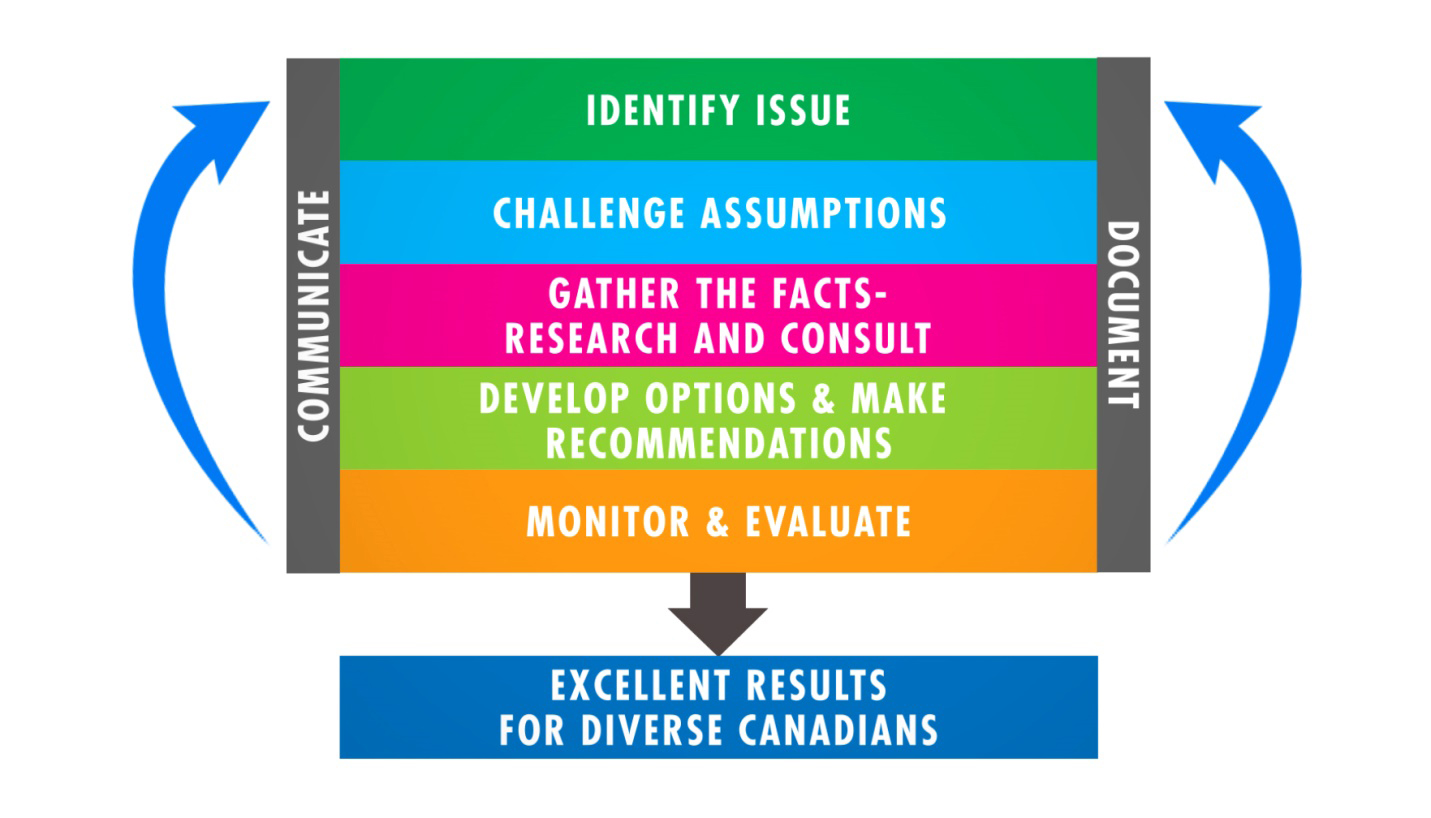Conduct a GBA+ analysis
Gender-based Analysis Plus (GBA+) is an analytical process used to assess how diverse groups of women, men and non-binary people may experience policies, programs and initiatives. The “plus” in GBA+ acknowledges that GBA goes beyond biological and socio-cultural differences. We all have multiple identity factors that intersect to make us who we are; GBA+ also considers many other identity factors, like race, ethnicity, religion, age, and mental or physical disability.
Use this play to...
- Conduct a GBA+ assessment
- Understand the diverse needs of users
Running the play
GBA+ is an analytical process used to assess how diverse groups of women, men and non-binary people may experience policies, programs and initiatives. The “plus” in GBA+ acknowledges that GBA goes beyond biological (sex) and socio-cultural (gender) differences. We all have multiple identity factors that intersect to make us who we are; GBA+ also considers many other identity factors, like race, ethnicity, religion, age, and mental or physical disability.
Without GBA+, we risk missing or misreading the experiences of a significant portion of the Canadian population and – as a consequence – risk developing policies and initiatives that can inadvertently increase inequalities. It is therefore critical that we apply GBA+ to optimize the impact and effectiveness of all federal initiatives.
Learn how to conduct a GBA+ assessment, following the Government of Canada GBA+ process, for your project or program by running this play. Remember that now is always the right time to start your GBA+. It works best if you start early, but you can start at any time and at any stage of a work cycle.
Before you start
The course Introduction to GBA+, offered by Status of Women Canada, is mandatory to all Transport Canada employees.
Chart illustrating the steps of a GBA+ assessment

Identify issues
The first step is to identify the context and the gender and diversity issues.
Nothing happens in a vacuum. Your initiative may have a narrow objective, but it will always be linked to broader government priorities. The social, cultural and economic environment are also important. Start by making these connections.
Tip
Remember: throughout your application of GBA+, document your process, findings, and results. This will help your team as well as other teams with other applications of GBA+ to their projects. You may also be asked to provide evidence that a GBA+ was conducted and to explain the process that guided your recommendations.
Challenge assumptions
We all have assumptions. In addition to our individual assumptions, the institution you work for may have formal or informal policies in place that can affect the development or outcome of an initiative. You need to be aware of these. Remember that workplace culture, behaviours, activities or processes all shape your assumptions.
Although the project you are working on may appear to affect everyone equally, always challenge your assumptions about whether it has gender and other diversity implications.
Tip
Use a modified version of the Do a disruptive brainstorming session play to challenge your team to remove pre-conceived ideas about gender and diversity!
Gather the facts: research and consult
The data you use should be gender-disaggregated and should include other intersecting identity factors, such as ethnicity, age or disability.
If information is not available, don’t abandon your analysis. Identify gaps in existing data and consider making data collection part of your initiative’s objectives and evaluation measures.
Make sure to use GBA+ when you design your consultation process. It is not enough to consult the general public and then apply your findings to all groups. Seek out multiple viewpoints. Engage Canadians of various identities, and consult broad and inclusive sources to deepen your analysis. Don’t forget: accessibility issues, social conditions and economic considerations can all affect someone’s ability to participate in your consultation process.
The results of your consultation and research should inform your options and recommendations at all stages of initiative development and implementation.
Develop options and make recommendations
Using the data you have gathered, indicate how the options you propose respond to the specific issues you identified. Present your GBA+ findings to decision-makers clearly. If you have found that your initiative could have differential impacts or unintended barriers, suggest strategies to strengthen the proposal. And be sure to highlight your plan to fill any data gaps that your GBA+ identified.
Monitor and evaluate
GBA+ also applies to the evaluation and monitoring of your initiative. The design of your evaluation framework and approach to monitoring can help address inequality and build capacity.
Make sure your evaluation identifies groups who are positively or negatively affected by the initiative. Highlight data gaps and address unintended outcomes for diverse groups. Incorporate them into strategy renewals or management responses.
Communication
Identify your target audiences, and tailor your messaging appropriately. Show how your initiative supports diversity, and use inclusive examples, languages and symbols. Review your messaging to ensure you are not perpetuating stereotypes. Whenever possible, choose images and language that challenge harmful stereotypes.
Finally, remember to share your GBA+ results. This will demonstrate due diligence, foster buy-in with stakeholders, and identify areas for further action.
Tip
The Conduct a change management kick-off meeting play can help your team come up with an effective communications plan – not only is it for big changes, but also to communicate exciting results!
Other resources on this topic
- GCPedia: GBA+ Home Page
- Status of Women Canada: GBA+
- Status of Women Canada: GBA+ Training Toolkit
- Canada School of Public Service: GBA+
Terms of use
Materials on this website were produced and/or compiled for the purpose of providing Canadians with access to information about the programs and services offered by the Government of Canada. It is subject to the following Terms and conditions.
This work is a derivative from “Gender-based Analysis Plus (GBA+)” by Status of Women Canada and used under the Open Government Licence – Canada.
- Date modified:
